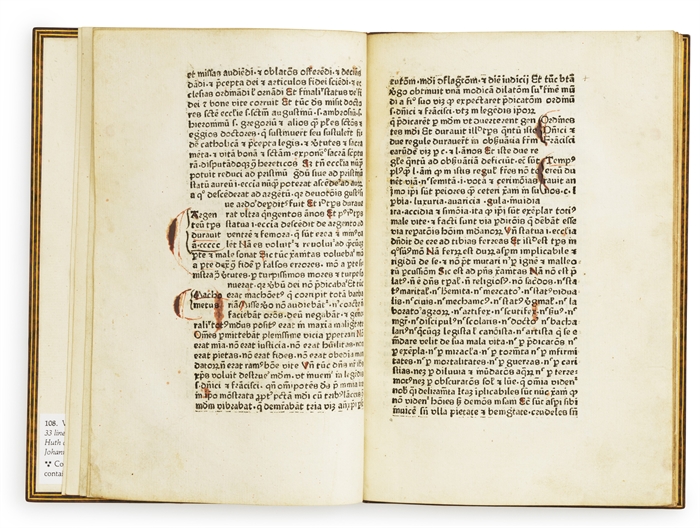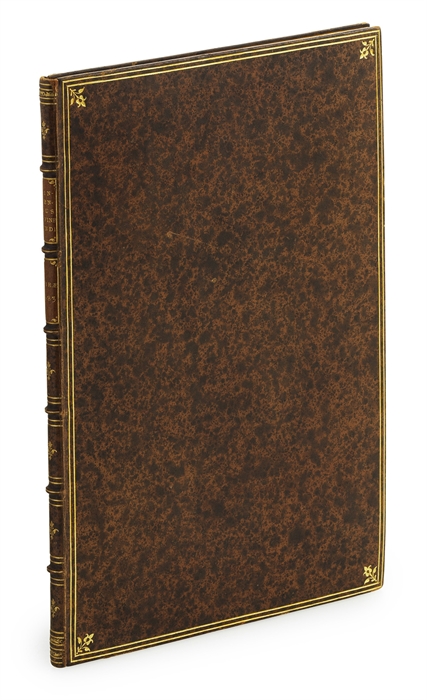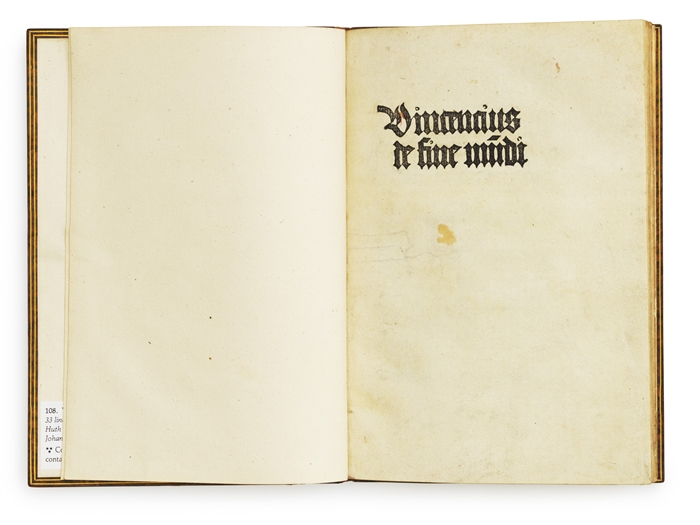ONLY KNOWN COPY OF THIS INCUNABLE-EDITION ON PRIVATE HANDS - THE HUTH-COPY
FERRER, VINCENTIUS.
De Fine Mundi.
Speier, Johann and Conrad Hist, (Colphon states 1455 which refers to when Ferrer was cannonized as a saint), circa 1485, no later than 1492.
4to (210 x 147 mm). In a very nice late 19th-century full sprinkled calf binding executed by Francis Bedford (signed in lower margin of verso of front board). Six raised bands and gilt lettering and ornamentation to spine. Double ruled fillets to recto and verso of borders of boards. Single gilt line decoration to edges of boards. All edges gilt. Old bookseller description and gilt ex-libris (Henry Huth (1815–1878), English banker and prominent bibliophile) pasted on to pasted down front end-paper. A few annotations in pencil to pasted down front end-papers. A few early marginal annotations and underlingnings. Initials in contemporary hand-colouring. 32 lines to a page. Washed. 19 ff. (a8- b-35). Wanting the final blank (c6). This is one of the few books which contains the brothers' joint colophon "ICH". Housed in a cloth clam-shell box.
Exceedingly rare, early incunable-edition of Ferrer’s highly popular, influential, and somewhat unsettling work containing his apocalyptic vision and eschatological preaching. Although several incunable-editions exist, they are rarely found in the trade and all are of the utmost scarcity. Of this edition we are only aware of one copy on private hands - namely, the present one, which last appeared for sale in 1985 (Bloomsbury Book Auctions, no. 45). The dating of this particular edition has puzzled bibliographers and still seems to leave many questions open: The colophone states 1455, which has often been referred to as an error in the year of imprint; in fact, it refers to the year that Ferrer was cannonized as a saint. For some reason (unknown to us), the Bloomsbury auction description dated it to 1491-1492. In their authoritative “Die Brüder Johann und Conrad Hist und ihre Drucke”, Engel and Stalla concluded that it must be from 1485, and the Gesamtkatalog der Wiegendrucke (GW) dates it to around 1483. The Vatican dates it to circa 1485. The Editio Princeps was printed by Gerardus de Lisa in Treviso in 1475. A second edition was printed, in Treviso or Vicenza, by Hermann Liechtenstein in 1477, and a third edition was printed in 1479 in either Toulouse or Lyon. The Zeninger-press in Nurnberg then printed a copy in 1480 or 1481. Despite being printed relatively frequently in the last quarter of the 15th century all editions are scarce and rarely find their way to the trade. The two brothers Hist settled in Speyer in January 1483. Only five incunabule editions from their joint production bear a colophon naming them both, i.e. Johann and Conrad (which this present edition does). These are dated between 1483 and 1488. Notably, in all five colophons, the printers' names are abbreviated as "ICH" rather than written out in full. Johann died or left at some point, but the exact date is unclear; Engel and Stalla mention 1489, others have stated 1492. Conrad Hist continued printing independently until 1515 and subsequently worked as a publisher and bookseller. Vincent Ferrer (1350–1419) was a Dominican friar from Valencia, Spain, known for his fiery preaching and missionary work across Europe. He was canonized as a saint in 1455. OCLC lists copies in Germany, 1 copy in Scotland, and 1 copy in The Vatican (Inc. IV. 413).
The present work reflects Ferrer's apocalyptic vision and eschatological preaching. Ferrer believed that the world was nearing its end and that humanity needed urgent repentance to prepare for the Final Judgment. His sermons and writings were deeply influenced by Medieval apocalypticism, writing on subjects like the Antichrist, the Last Judgment and divine retribution. Ferrer’s somewhat distressing writings and the fact that he thought he was divinely appointed to warn the world of its impending end earned him the nickname "Angel of the Apocalypse".
The Huth library. A catalogue of the printed books, vol 2, p. 512.
Not in BMC; not in Goff.
GW 09852.
See: Engel, Hermann/Stalla, Gerhard (1976), "Die Brüder Johann und Conrad Hist und ihre Drucke“, in: Archiv für Geschichte des Buchwesens 16.
Order-nr.: 62018




